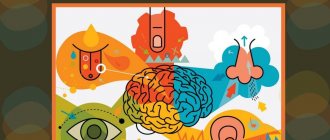Anyone who is interested in psychology, studies people and wants to learn how to influence them probably realizes the importance of understanding feelings, emotions and sensations. These three mental processes are reflected in facial expressions, gestures, posture and other elements of body language. A person is an open book that can be learned to read.
After reading this article and understanding what feelings, emotions and sensations are, you can take our profiling course, where you will learn to analyze people, their facial expressions, gestures, actions in order to better understand their motives and feelings. Let's study these concepts one by one and try to understand how this knowledge will help us better understand and influence people.
Emotions are speed. Verbs or adjectives
The speed at which we speak also conveys emotions. We can speak excitedly, with feeling, restlessly, loudly. Or we can - slowly, embarrassedly, sluggishly, shutting up on every word. How to convey this in text?
Adjectives slow down the text, so when conveying emotions using these parts of speech, the main thing is not to slow down the narrative.
Verbs speed up. We write on social networks, so speed is important. Readers rush through our texts at the speed of Formula 1 race leaders. If we are slow, we will fall behind them.
Of course, all this does not mean that you need to write only in verbs and forget about adjectives. Everything is good in moderation and, most importantly, understand where to correct when you feel that the text is marking time.
List of moral, intellectual, aesthetic feelings
To the question: “what are the feelings,” each person can give his own answer. Some people often experience strong and deep experiences, while others experience them mildly and short-lived. The ability to feel depends on the temperament, character, principles, priorities and life experience of the individual.
Most often, feelings are classified depending on the sphere in which the object of experience is located:
- Moral
These are sympathy and antipathy, respect and contempt, affection and alienation, love and hatred, as well as feelings of gratitude, collectivism, friendship and conscience. They arise in relation to the actions of other people or their own.
They are determined by the moral norms accepted in society and acquired by the individual in the process of socialization, as well as his views, beliefs, and worldview. If other people's or one's own actions correspond to moral standards, satisfaction arises; if not, indignation arises.
- Intelligent
A person also has experiences that arise in the process of mental activity or in connection with its result: joy, satisfaction from the process and result of work, discovery, invention. It is also inspiration and bitterness from failure.
- Aesthetic
Emotional excitement arises when perceiving or creating something beautiful. A person experiences incredible sensations when he sees the beauty of the Earth or the power of natural phenomena.
A person feels a sense of beauty when looking at a small child or an adult, harmoniously built person. Beautiful works of art and other human creations can evoke delight and elation.
Since this classification does not reveal the entire palette of feelings, they are usually classified on several other grounds.
How to convey emotions with certain words
1. If you do use adjectives , do not write them with the word “very”, for example, “very beautiful”. Use a stronger word immediately, in this case, “magnificent.” However, make sure that the word carries the desired meaning and paints a picture.
Very beautiful - magnificent
Very scary - terrible
2. Use synonyms. There are many more words than those that come to our minds at the first moment. You can find entire dictionaries on the Internet. Here is one of them that I use myself: https://synonymonline.ru.
Beautiful - elegant, graceful, charming, charming, spectacular, bright, good, picturesque, brilliant, prominent, artistic, etc.
Terrible - menacing, insidious, devilish, ugly, frightening, tragic, murderous, catastrophic, disastrous, dashing, unattractive, etc.
By the way, have you noticed that just reading these words, you already have certain feelings?
Well, to restore balance, read these lines:
Hope - prospect, expectation, faith, chance, hope, aspiration, presentiment, dream, perspective, illusion, anticipation, presentiment.
3. There are magic phrases with which you can reach the reader’s heart. Sasha Karepina figuratively writes about this in her book “We Write Convincingly.” I'll give you a few examples.
Will add emotions | They will ruin your text |
| Personal pronouns I ask you to make payments on time. We ask you to forgive us. We behaved inappropriately. | Impersonal nouns The administration is not responsible for items left behind. The company sincerely apologizes to you. |
| Request, direct appeal Please indicate the exact address where to send the parcel. | Statement of facts The postal address must be indicated completely and without errors. |
| Evaluative Expressions I failed my job We won this competition | Objective analysis of facts The result I was striving for was not achieved. A positive result was obtained |
| Active speed Let's do... I suggest... | Passive revolutions Performed… I would like to suggest... |
| Simple words Explanation Now Use enjoy | Book designs Interpretation Currently Apply exploit |
| Active voice Our workshop offers art products. | Passive Voice Art supplies are offered by our workshop. |
| Mention of feelings I was saddened to learn that... We were happy when we heard... | Stationery clichés As a result of the work carried out... The exhibition aims… |
How do feelings differ from emotions?
All people experience emotional experiences and worries, but not everyone knows how to name them and express them in words. But it is precisely the knowledge of what feelings there are that helps not only to correctly identify, but also to control and manage them.
Feelings are a set of experiences associated with people, objects or events. They express a subjective evaluative attitude towards real or abstract objects.
People in everyday life and some psychologists use the words “feelings” and “emotions” as synonymous words. Others say that feelings are a type of emotion, namely higher emotions. Still others share these concepts: emotions belong to the class of mental states, and feelings to mental properties.
Yes, there is a direct relationship between them, because they are human experiences. Without emotional unrest, an individual would not live, but exist. They fill life with meaning and make it diverse.
But there are still significant differences between feelings and emotions:
- Emotions are innate and instinctive reactions of the body to changes in the environment, feelings are social, developed in the process of upbringing and learning experiences. A person learns to feel, everyone knows how to express emotions from the moment of birth.
- Emotions are difficult to control through willpower; feelings are easier to manage, despite their complexity and ambiguity. Most of them arise in a person’s consciousness; emotions are often not realized, as they are associated with the need to satisfy an instinctive need.
- A feeling changes, develops and fades, varies in strength, manifests itself in different ways, can develop into its opposite, an emotion is a certain reaction. For example, if a person experiences hatred for another person, it is possible that this experience will develop into love, and the emotion of fear is always fear, regardless of the object (it can also be causeless). There is either fear or there is no fear.
- Emotions do not have an objective correlation, feelings do. They are experienced in relation to something or someone differently. For example, loving a child is not the same as loving a spouse. And for example, bewilderment is always expressed in the same way, regardless of what specifically causes it.
- Feelings are a stronger motivator than emotions. They encourage, inspire, push to perform actions in relation to the object at which they are directed. Emotions only give rise to actions in the form of responses.
- Emotions are short-lived and superficial, although vivid manifestations, but feelings are always complex and strong emotional disturbances.
It can be difficult to determine when a combination of emotions will give rise to a feeling, and what higher experience is expressed in a particular series of emotional manifestations. These are close, accompanying phenomena, but they still need to be distinguished. The individual is responsible for his highest emotions and for the actions that they entail.
How to convey emotions by drawing a picture
Yes, we can convey emotions using various adjectives, but if they are not filled with a meaning that is understandable to the reader, they will be empty. For example,
A gourmet breakfast awaits each guest. We offer high-quality European cuisine with a delicate taste and unique aroma.
And if so?
When you wake up, you can come down to our restaurant. We will prepare for you a cup of coffee, a freshly baked baguette and soft butter. If desired, instead of butter you can order jam or chocolate spread. For an additional fee, we will prepare for you scrambled eggs and bacon or oatmeal with milk. Butter, eggs and milk are supplied to our kitchen every morning from our own farm.
The picture is filled with feelings; while reading, we imagine the smell of coffee and fried bacon, and crispy bread with butter is already melting in our mouth.
Open the world of your own emotions
The ability to recognize your feelings is not only possible, it must be trained. To do this you can:
- Observe what bodily sensations occur in a certain situation. For example, a common feeling is a lump in the throat. You need to track this and try not to suppress it - go for this discomfort and allow it to manifest itself. Let the tears fall - if necessary.
- Observe what bodily sensations occur in a certain situation. For example, a common feeling is a lump in the throat. You need to track this and try not to suppress it - go for this discomfort and allow it to manifest itself. Let the tears fall - if necessary.
- Observe what bodily sensations occur in a certain situation. For example, a common feeling is a lump in the throat. You need to track this and try not to suppress it - go for this discomfort and allow it to manifest itself. Let the tears fall - if necessary.
- Observe what bodily sensations occur in a certain situation. For example, a common feeling is a lump in the throat. You need to track this and try not to suppress it - go for this discomfort and allow it to manifest itself. Let the tears fall - if necessary.
These workouts will give good results over time.
Where can you use emotional descriptions?
Believe me - everywhere. After all, we already realized that we are not talking about sentences screaming with three exclamation marks and CAPITAL letters:
BUY!!!
Get UNMATCHED results and a UNIQUE ATMOSPHERE IN YOUR HOUSE!!!
Emotional, and therefore human, descriptions can be used even when talking about the terms of payment and delivery or the rules of the group. After all, is it important to you how the person reading your lines feels? That communicating with you is simple and pleasant, or difficult and dreary.
Compare the two options. Which one do you like better?
“Payment for goods can be made using payment terminals, electronic payment systems or via bank transfer.”
“You can pay for the goods with electronic money, use your bank card and make an online payment, or transfer money at the nearest payment terminal.”
Classification of feelings
To understand what feelings are, you need to understand by what criteria they can be assessed. Criteria are another basis for classification.
Criteria serve so that experiences can be measured, characterized and called into words, that is, defined.
There are three criteria of feelings:
- valence (tone);
- intensity (strength);
- sthenicity (activity or passivity).
Feelings table No. 1 allows you to characterize any difficult experience:
| CRITERIA | KINDS | ||
| Valence | Positive | Negative | Neutral (ambivalent) |
| Intensity | Strong | Weak | Medium in strength |
| Sthenicity | Stenic (encouraging activity) | Asthenic (passive, relaxing) | |
For example, a person may experience a positive, strong sthenic experience. It could be love. If the intensity of the sensations is weak, it is just sympathy.
The table of feelings, characterizing experiences, does not allow us to name them in words. The name can only be guessed. A person does not always have enough knowledge and experience to decide how to correctly name the emotional excitement he is experiencing. This is not surprising, since there are a lot of them. However, some people cannot name even ten feelings, but this is how many, on average, a person experiences every day.
The third basis for classifying socially determined experiences is depending on the basic emotion.
American psychologist Paul Ekman identified seven basic emotions:
- joy;
- sadness;
- anger;
- fear;
- astonishment;
- disgust;
- contempt.
Table of feelings No. 2 involves searching for the name of the emotional experience being experienced, starting from the first four basic emotions:
| BASIC EMOTION | DERIVATIVES |
| Fear | Anxiety, confusion, panic, nervousness, mistrust, uncertainty, uncertainty, apprehension, embarrassment, anxiety, doubt and others. |
| Sadness | Apathy, despair, guilt, resentment, concern, sadness, depression, weakness, shame, boredom, melancholy, depression, fatigue and others. |
| Anger | Aggression, rage, disgust, rage, anger, envy, hatred, dissatisfaction, disgust, intolerance, disgust, contempt, neglect, jealousy, frustration, cynicism and others. |
| Joy | Cheerfulness, bliss, delight, dignity, trust, curiosity, relief, revitalization, optimism, peace, happiness, tranquility, confidence, satisfaction, love, tenderness, compassion, euphoria, ecstasy and others. |
The second table of feelings complements the first. By using both of them, you can understand what kind of power has taken over the mind and heart, how to describe and name it. And this is the first right step towards awareness.











